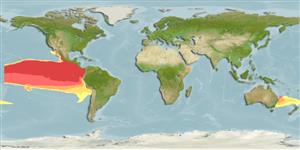Environment: milieu / climate zone / depth range / distribution range
Ecologia
marino; oceanodromo (Ref. 51243); distribuzione batimetrica ? - 50 m (Ref. 37955). Tropical; 30°N -
Eastern Central Pacific: western coast of Baja California, Mexico to Peru (Ref. 11482).
Size / Peso / Age
Maturity: Lm ? range ? - ? cm
Max length : 37.0 cm TL maschio/sesso non determinato; (Ref. 55763); common length : 20.0 cm TL maschio/sesso non determinato; (Ref. 55763)
Body elongate, moderately deep, and compressed; snout slightly pointed; adipose eyelid poorly developed; lower branch of the first gill arch with 28 to 30 gill rakers; chest entirely covered by scales; lateral line arched anteriorly, with 46 to 53 strong scutes in the straight part; back gray blue; belly silvery with green-gold highlights; 8 to 9 incomplete, dark, vertical bars along the flanks; edge of operculum with a very conspicuous black stain (Ref. 55763).
Adults inhabit coastal and oceanic waters (Ref. 9283). They feed on small fishes, crustaceans and other benthic invertebrates (Ref. 37955). Marketed fresh and salted or dried (Ref. 9283).
Life cycle and mating behavior
Maturità | Riproduzione | Deposizione | Uova | Fecundity | Larve
Allen, G.R. and D.R. Robertson, 1994. Fishes of the tropical eastern Pacific. University of Hawaii Press, Honolulu. 332 p. (Ref. 11482)
IUCN Red List Status (Ref. 130435)
Threat to humans
Harmless
Human uses
Pesca: commerciale; Pesce da pesca sportiva: si
Informazioni ulteriori
BibliografiaAcquacolturaProfilo di acquacolturaVarietàGeneticaElectrophoresesEreditarietàMalattieElaborazioneNutrientsMass conversion
Strumenti
Special reports
Download XML
Fonti Internet
Estimates based on models
Preferred temperature (Ref.
123201): 21.8 - 28.5, mean 26.3 °C (based on 52 cells).
Phylogenetic diversity index (Ref.
82804): PD
50 = 0.5000 [Uniqueness, from 0.5 = low to 2.0 = high].
Bayesian length-weight: a=0.01738 (0.00796 - 0.03794), b=2.94 (2.77 - 3.11), in cm total length, based on LWR estimates for this Genus-body shape (Ref.
93245).
Trophic level (Ref.
69278): 3.7 ±0.54 se; based on food items.
Resilienza (Ref.
120179): Alto, tempo minimo di raddoppiamento della popolazione meno di 15 mesi (Preliminary K or Fecundity.).
Fishing Vulnerability (Ref.
59153): Low to moderate vulnerability (27 of 100).
